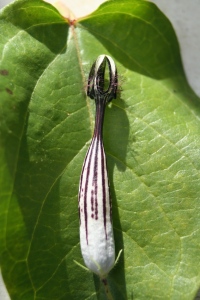A rare Ceropegia that comes from Maji Ya Chumvi on the Mombassa Road between Voi and Mombassa. It grows in an area that is very hot, reaching temperatures of 40°C. It looks similar to Ceropegia sandersonii with a parachute-like structure. It grows mostly in Acacia shrubs where it gets protection from goats. It also grows in other shrubs and in grass, but it is then more likely to be eaten by the goats.
It can grow up to 2 metres in length and the stems are very similar to those of Ceropegia ampliata with the same small leaves, but the stems are grey in stead of green. The roots are fusiform, that is to say, thick and spindle-like. One specimen was found last year in flower. This year, I searched the same area and after twenty minutes I found one plant with a seedpod from which I collected some seed. I sowed some in my greenhouse and some have been put in tissue-culture to get this species into circulation to collectors. The seed has germinated and the plants are growing reasonably well. Patience, patience ….














